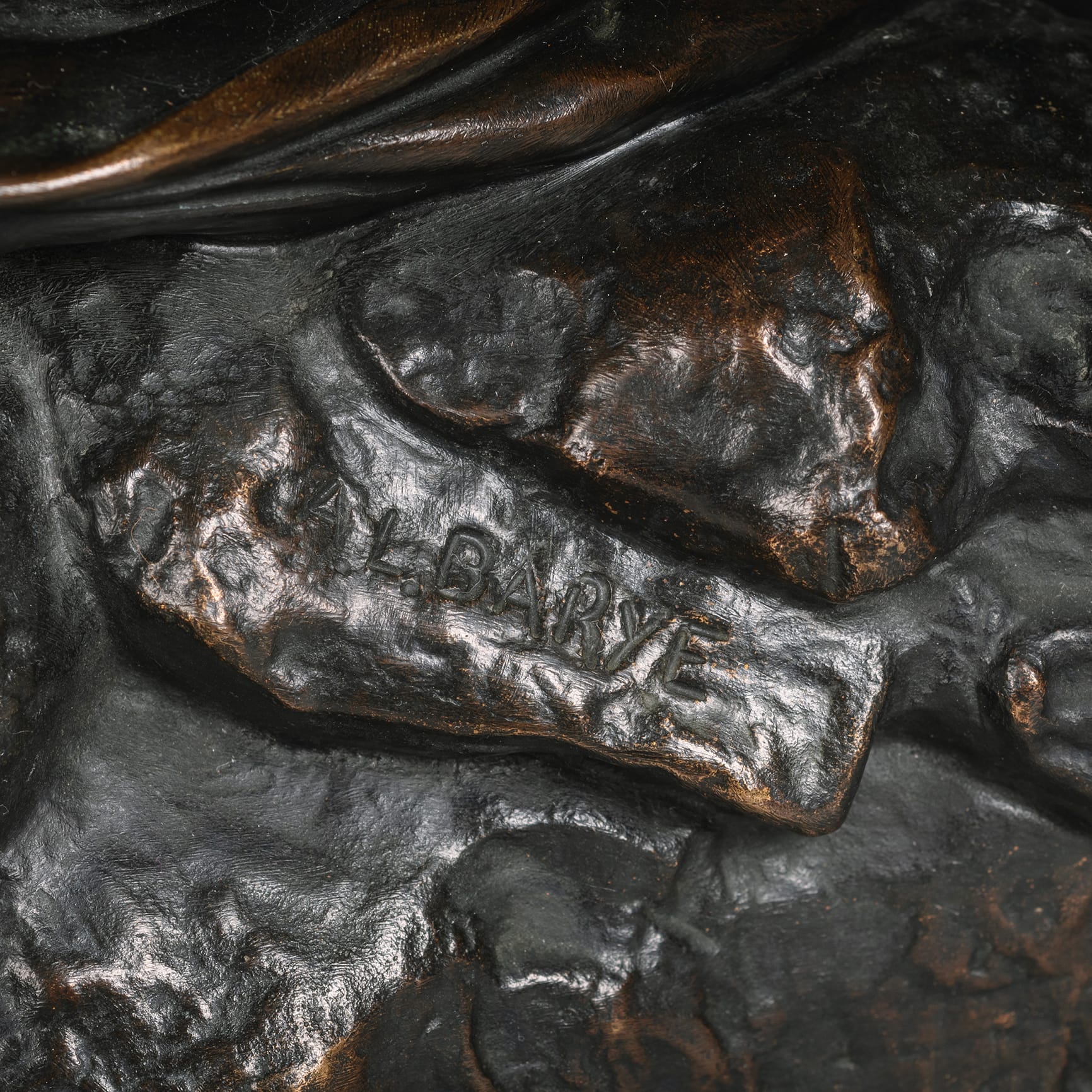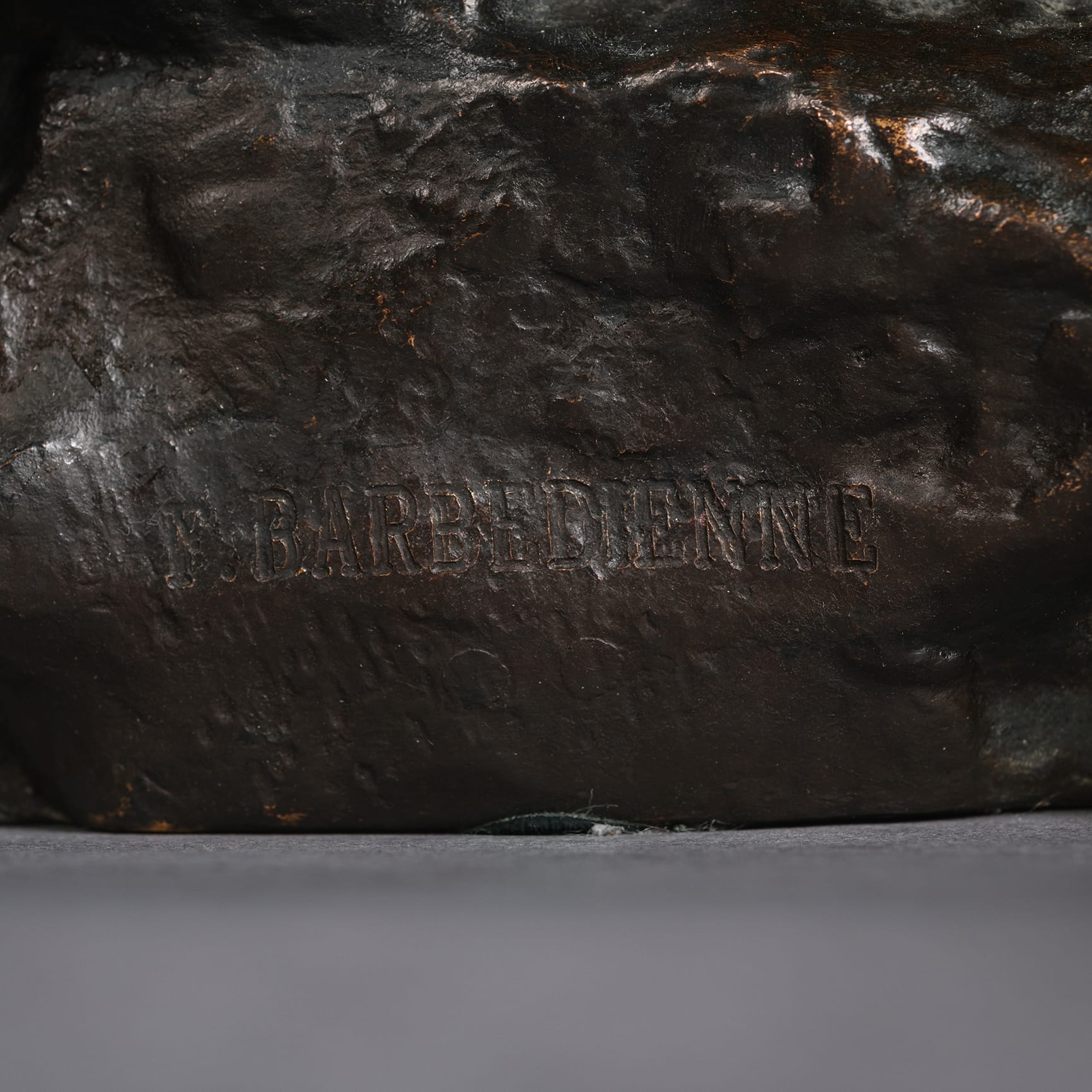Antoine-Louis Barye (French, 1795-1875)
‘Theseus Fighting The Centaur Bianor’ – A Patinated Bronze Figural Group
£14,000
A Fine Patinated Bronze Group, Entitled 'Thesée Combattant le Centaure Bianor' ('Theseus Fighting the Centaur Bianor'), By Antoine Louis Barye (1795-1875). Signed...
Dimensions
Height: 41 cm (17 in)Width: 16 cm (7 in)
Depth: 6 cm (3 in)
Description
A Fine Patinated Bronze Group, Entitled ‘Thesée Combattant le Centaure Bianor’ (‘Theseus Fighting the Centaur Bianor’), By Antoine Louis Barye (1795-1875).
Signed ‘A. L. BARYE’ and stamped ‘F. BARBEDIENNE’.
The model conceived Circa 1850. This example cast as part of a limited edition by Ferdinand Barbediene, France, Circa 1880.
The subject of Theseus Fighting the Centaur Bianor is taken from an incident from the battle of the Lapiths and the Centaurs described in Book XII of Ovid’s Metamorphoses. Theseus, King of Athens and one of the great heroes of Greek mythology, was invited to attend the wedding of his good friend Pirithous, the king of the Lapiths, and Hippodamia. The king also invited his neighbours, the half-human, half-horse Centaurs. The centaurs became drunk and unruly, attempting to abduct the bride and other female guests. Swiftly, Theseus, renowned for his valor, stepped into the fray, engaging in combat to repel the Centaurs and successfully safeguard the bride.
The plaster model of ‘Theseus Fighting the Centaur Bianor’ was exhibited at the Salon in 1850 (no. 3171). The group was edited posthumously by Barbedienne in four reductions, this being an example of the smallest size. Other examples are held in the Musée du Louvre (inv. no. OA 5726), the Metropolitan Museum of Art (inv. no. 10133.4) and the National Gallery of Art, Washington D.C. (inv. no. 2014.136.279)
Date
Circa 1880
Origin
France
Medium
Patinated Bronze
Signature
Signed 'A. L. BARYE' and stamped 'F. BARBEDIENNE'.
Antoine-Louis Barye was dubbed the ‘Michelangelo of the Menagerie’ by the celebrated art critic, Théophile Gautier, in L’Illustration, May 1866. As a Romantic French sculptor most famous for his work as an ‘animalier’, a sculptor of animals, Barye achieved international acclaim during his lifetime, but his celebrity has grown ever since and today he is remembered as one of the most important and identifiable sculptors of the nineteenth century. Born in Paris in 1795 (a date revised in the 1990s from 1796 as a result of Martin Sonnabend’s recalculation of the Revolutionary calendar), Barye worked with his father, a goldsmith from Lyons, then at the age of thirteen he was apprenticed to Fourrier, an engraver of military equipment. Later he switched to the jewellery trade and learned the technique of moulding reliefs from Martin-Guillaume Biennais (active 1800-1832), then master goldsmith to Napoléon. Barye’s official schooling in sculpture began in 1816 under François-Joseph Bosio (1768-1845) and the painter Baron Gros (1771-1835). In these young years Barye observed the most sophisticated technical practices of the Parisian goldsmiths as well as encountering neo-classical and antique models, an influence that would have lasting effect.
In 1819 Barye took part in the competition of the Ecole des Beaux-Arts and was runner up with a medallion of ‘Milo of Crotona Devoured by a Lion’. He won second prize in 1820 with his figure of Cain cursed by God. Barye worked with the goldsmith Jacques-Henri Fauconnier (1779-1839) from 1823 to 1831, continued to practise modelling in his spare time, studying ancient sculpture at the Louvre.and made his Salon debut in 1827 with a selection of busts.
The other experience of his youth which was essential to Barye, was his dedicated studies of wild animals in the Paris Zoo. All these varied interests were fused together in the driving ambition and creative energy of this remarkable sculptor to produce for the Salon of 1831 a work that laid siege to the Parisian sculptural establishment. The plaster model of ‘Tiger Devouring a Gavial’ was in every way unprecedented, and even the basically unsympathetic critic Delecluze was forced to admit that the group was ‘the strongest and most significant work of sculpture in the whole Salon’ – this marked the turning point in Barye’s career. He established his own studio and was awarded the Légion d’Honneur in 1833 and was promoted to chevalier in 1855. Triumphant recognition came early when the Minister of the Interior purchased Bayre’s monumental plaster of ‘Lion Crushing a Serpent’ at the 1833 Salon and had it cast in bronze to be displayed outside the Louvre. The pendant for which, ‘Seated Lion’, was commissioned in 1846. Ensuing state commissions included a colossal eagle to crown a triumphant arch at the Etoile, which was never completed, and in the early 1840s a monumental effigy of Saint Clotilde for the Church of the Madeleine, Paris. During these years Barye received the patronage of the royal family who began to commission him to produce small scale works, the most famous of which was a surtout de table representing hunts of different regions and historical periods for the Duc d’Orléans in 1834.
Barye is thought to have had limited formal schooling, the extensive knowledge of science and art history becoming of his brilliance was wrought from experience and self-taught. His artistic genius overcame such limitations and he fraternised with the highest echelons of society, becoming a figure of the artistic establishment. However, his rise was not without setbacks, notably only rarely exhibiting at the Salon after 1837 when his surtout elements were rejected. Of greater impact was the death of the duc d’Orléans in 1842 and the subsequent Revolution of February 1848, after which Barye was unable to capitalize on royal patronage, and embarked on a new venture which would come to define his career.
Utilising his skill with metalworking, Barye saw the opportunity to commercialise his smaller figural and ornamental works by undertaking editions of small-scale bronzes firstly with the foundry Maison Basse from 1844, then independently and in partnership with Emile Martin from 1845 to 1857. Barye maintained artistic control and either directly played a part in, or oversaw, the casting process to ensure the standard of limited editions. This serialisation assured Bayre’s legacy by making his art more attainable to the new middle classes and known across Europe and the Americas. In his widely respected catalogue raisonné, published in 1974, Stuart Pivar aptly refers to a certain ‘quality’ about Barye bronzes, which renders them ’eminently collectable’.
Under the Second Empire, Bayre’s reputation grew steadily. He obtained several important State commissions, became master of zoological drawing at the Muséum d’Histoire Naturelle, where the young Rodin briefly studied with him in 1863. He won a gold medal for technical excellence in the industrial arts section of the Paris 1855 Universal Exhibition. Finding himself more in favour than ever under Napoléon III he was showered with distinctions including being elected to the Institut de France in 1868. Barye once again received prestigious government commissions for monumental sculpture, including architectural sculpture for the Pont Neuf and the façade of the Louvre. Unfortunately, the downfall of Napoléon III adversely affected Barye’s work, which included a series of Napoleonic statues which were hastily removed from public view. Barye died in Paris in 1875, and after an elaborate funeral befitting his artistic stature he was buried at Père-Lachaise Cemetery. The Vente Atelier Barye was held at hôtel Drouot, Paris, 7-12 February 1876 where the rights of reproduction to Barye’s models were bought by the Brame and Barbedienne foundries.
Barye was a master of anatomical form, whether human or animal, and established a benchmark for animal sculpture. His representations of predatory violence in the wild, such as his royal stag brought down by Scottish hounds, wowed critics and the Victorians especially showed a fondness for what they considered to be the high morality of this type of animal drama. It is an impressive indication of Barye’s pure aesthetic qualities that his sculpture resonates more strongly today than equivalent paintings. In a career spanning half a century Barye had a prodigious output of bronzes covering every aspect of animal life, from the domestic to the exotic, embued with a realism and naturalism and a meticulous attention to anatomical detail.
Makers Bibliography:
Pivar, Stuart ‘Barye Bronzes: A Catalogue Raisonné’, Antique Collectors Club, 1974.
Cooper, Jeremy ’19th Century Romantic Bronzes, French, English and American Bronzes, 1830-1915′; New York Graphic Society, 1975.
Kjellberg, Pierre ‘Les Bronzes du XIX Siècle’, Editions de l’Amateur, 1987, pps. 54-84.
Poletti, Michel and Richarme, Alain ‘Barye : catalogue raisonné des sculptures’, Gallimard, 2000.
Arsene, Alexandre ‘A.L. Barye’ Kessinger Publishing, 2010.
G. F. Benge, Antoine-Louis Barye. Sculptor of Romantic Realism, London, 1984, pp. 48-9.
M. Poletti and A. Richarme, Barye. Catalogue raisonné des sculptures, Paris, 2000, no. F33, p.109.
W. R. Johnston and S. Kelly, Untamed: The Art of Antoine-Louis Barye, exhib. cat. The Walters Art Museum, Munich/ London/ New York, 2006, no. 63, pp. 164-5














 Print
Print


